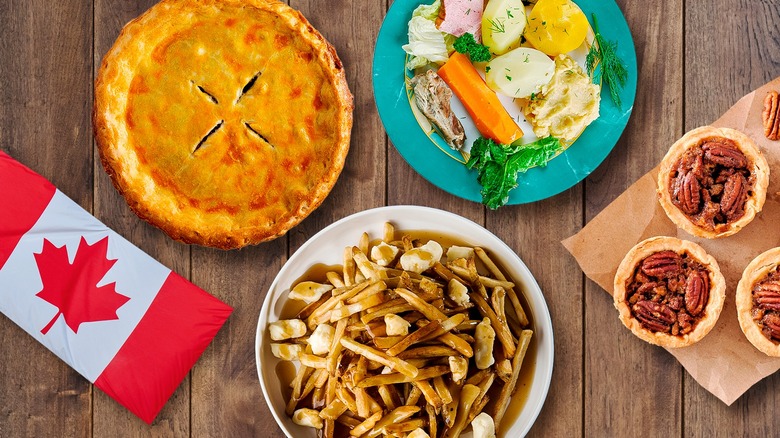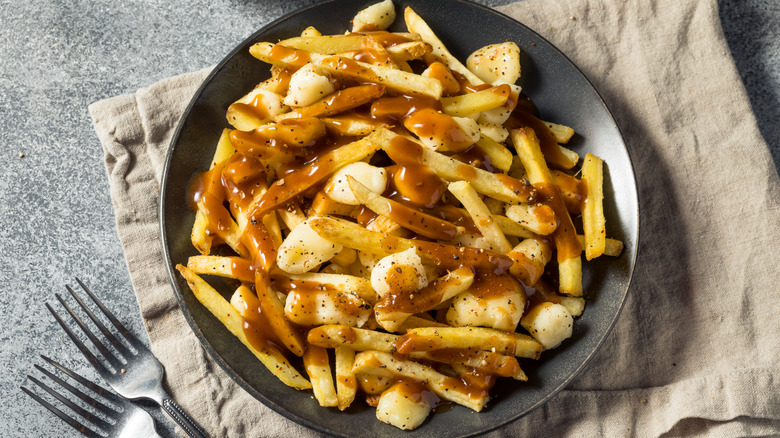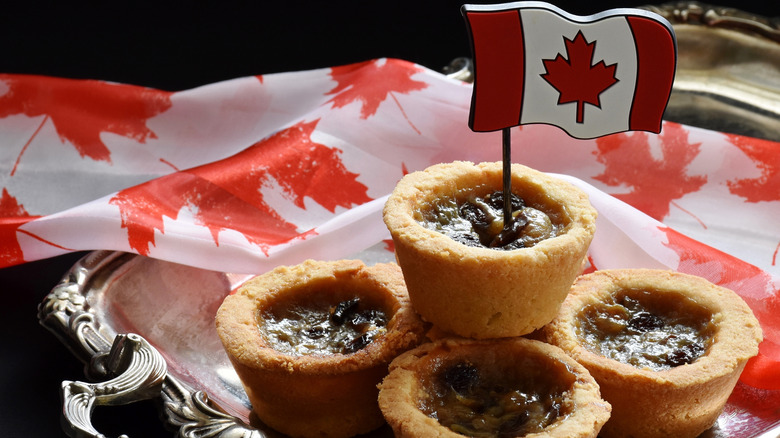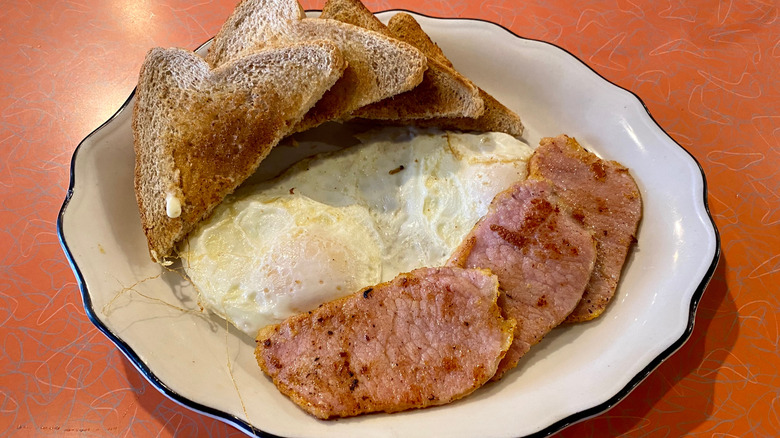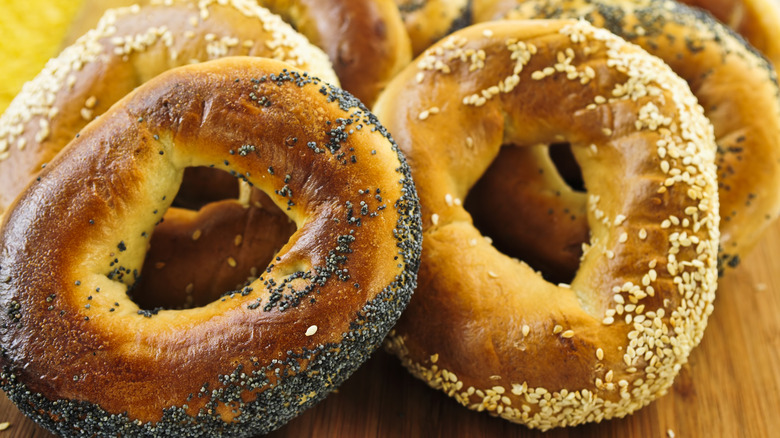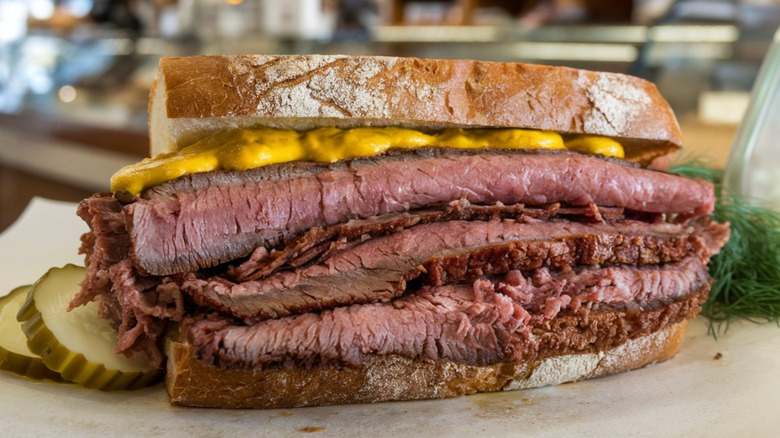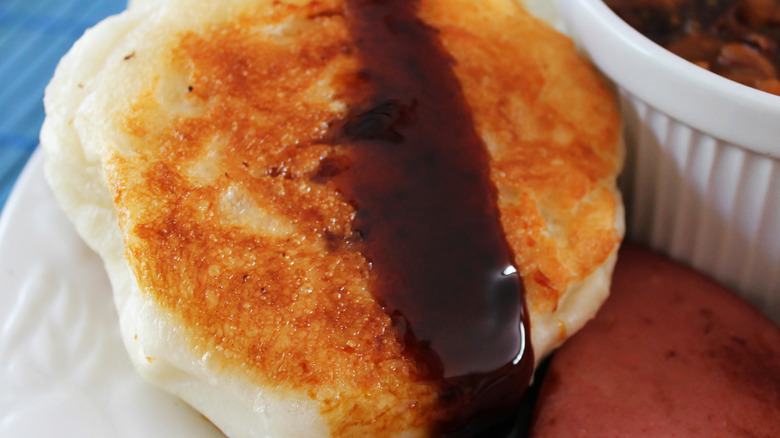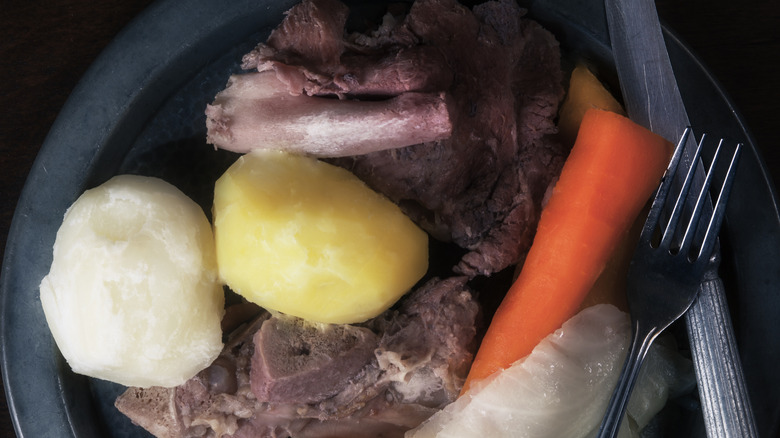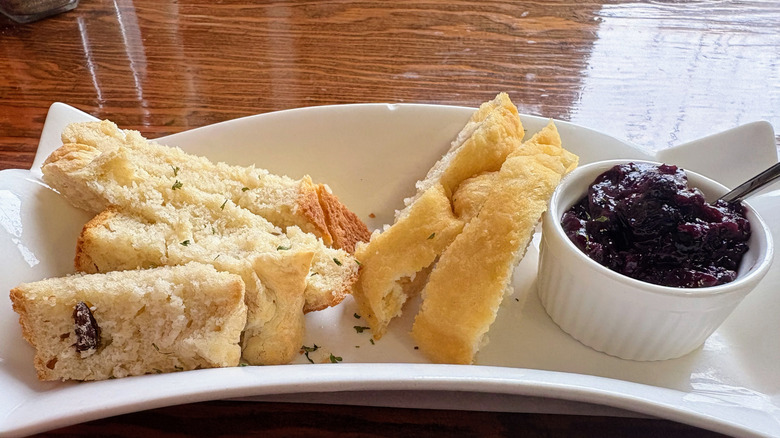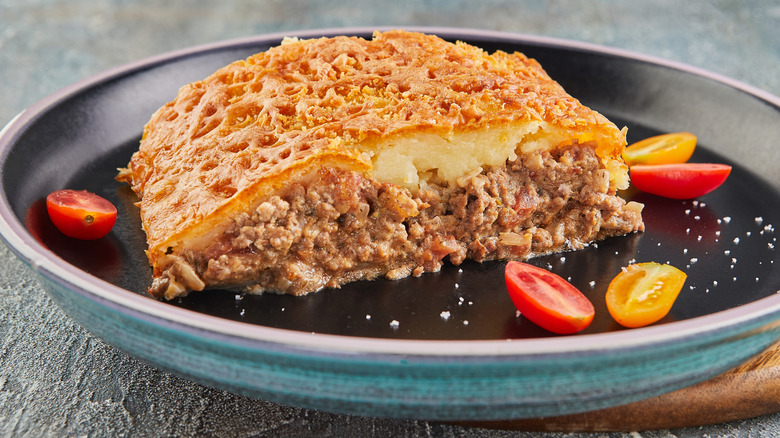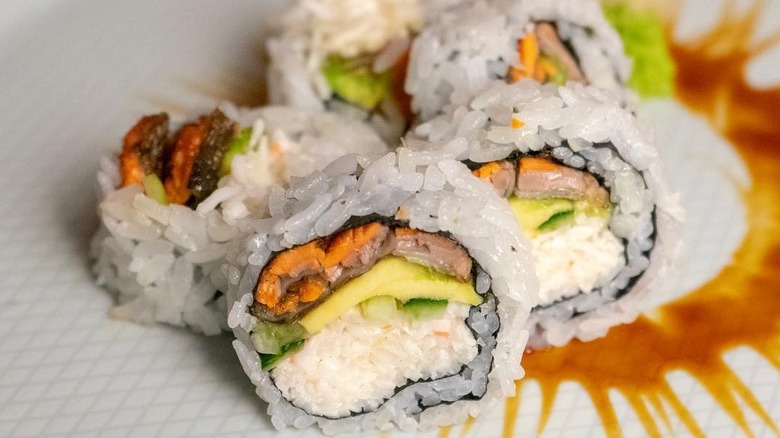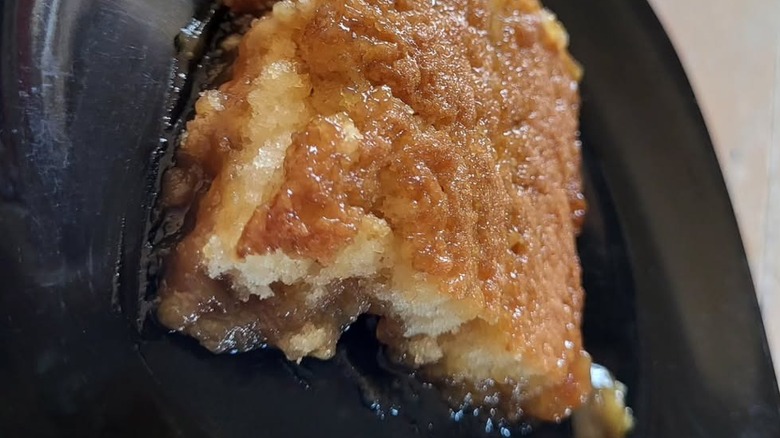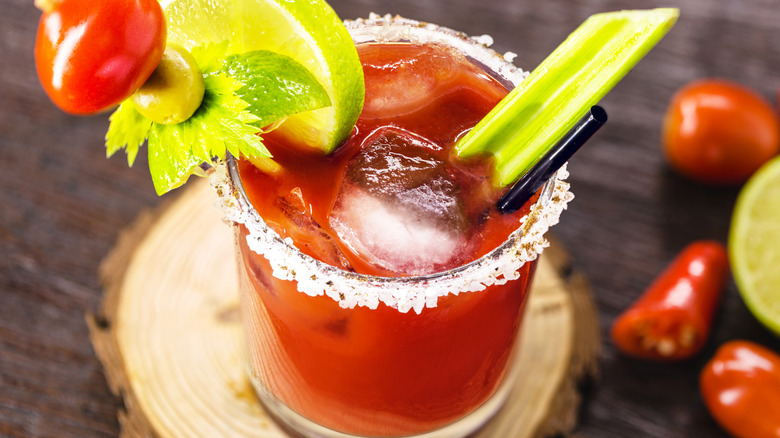Popular Canadian Foods Everyone Should Try At Least Once
Canada and the United States have historically enjoyed a friendly but distant relationship, culturally speaking. Both countries share a language (or at least one of them; French is one of Canada's two official tongues, along with English) and certain standards of living. Canadian artists and entertainers often make their way south to try their luck in the larger American market, and many U.S.-based restaurants have thrived for decades after expanding into Canada. We all even eat a lot of the same foods, heavily influenced by a shared legacy of Western European colonialism and heritage. But if one looks closely, beyond the plethora of A&W burger joints and Tim Hortons coffee and doughnut shops, they'll see that the U.S. and Canada diverge quite a bit when it comes to what we eat. For example, there are numerous Canadian fast food chains that we'd love to see in the U.S., because there are some foods that Canadians do better than Americans.
And while the U.S. has exported much of its diet to Canada, the reverse is relatively rare. That's quite unfortunate, because there are lots of delicious, quintessentially and proudly Canadian foods that would probably earn a following in the U.S. if more Americans were aware of them. Here then are some essential Canadian dishes that are very much worth a taste.
Poutine
Considered a national dish of Canada, poutine combines a few simple ingredients beloved all over, but particularly in the United States: french fries, gravy, and cheese. Developed in Quebec in the 1950s, likely at a restaurant called Le Lutin qui rit, poutine — French-Canadian slang for "mess" — consists of a pile of crispy, thick-cut fries that, immediately after getting taken out of the oil, are topped with a generous amount of bouncy and salty cheddar cheese curds. The whole thing then gets doused in brown gravy.
Poutine is popular across Canada, served in its original form and in an almost endless array of imaginative versions incorporating meats, sauces, and other kinds of cheese. It pops up at restaurants, bars, vendors on the street, dedicated poutine parlors, and even at fast food places like McDonald's. It's consumed most often in the provinces of Quebec, Ontario, and British Columbia, and while it's certainly the inspiration for the common American diner food of disco fries, there's nothing quite like the combo of brown gravy and cheese curds.
Butter tarts
The European settlers who established what came to be known as Canada were from many countries, including France and Scotland. Those overlapping cultures appropriately both try to stake a claim as the originator of what's considered the flagship Canadian dessert or baked good, butter tarts. Gooey and heavily sweetened miniature pies similar to the filling used in pecan pies in the U.S., butter tarts are so loved in Canada that they once appeared on a postage stamp.
The first time butter tarts were mentioned in print was in 1900, in the Ontario-published "The Women's Auxiliary of the Royal Victoria Hospital Cookbook," likely an adaptation of a recipe brought to Canada in the 1600s by French settlers who made classic sugar pies but with the ingredients they could get in the New World. There's also an argument to be made that butter tarts are a North American evolution and renaming of a simple dessert from Scotland known as border tarts. Whichever its vintage, butter tarts are easily changed, based on individual preferences. Sometimes they have nuts, sometimes they don't, and sometimes they're made with raisins, but then just as often not.
Nanaimo bars
Recipes for dessert bars, or layered cookies, could be found throughout North American magazines and cookbooks in the mid-20th century, but the greatest one of all just might be the Nanaimo bar.
Nanaimo is a moderately large city on Vancouver Island, across a bay from the metropolis of Vancouver where in 1952, the "Women's Auxiliary of the Nanaimo Hospital Cookbook" published an unattributed recipe for "chocolate squares." The dessert utilized a base layer made in part from a combo of crushed graham crackers and sweetened coconut that ran in a Vancouver Sun cooking column in 1948. As dual-income families became more prevalent in Canada in the 1950s, baking got less popular but Nanaimo bars were made and consumed more because they're so easy to prepare. The treat remained a regional specialty until Expo '86, a world's fair held in Vancouver in 1986, served them to crowds, and printed the recipe in a top-selling souvenir cookbook. They're pretty much made the same way today: a bottom layer of coconut, chocolate, and graham crackers, covered with a sweetened and hardened custard, and then chocolate ganache on top.
Peameal bacon
Are Canadian bacon and ham actually the same thing? No, but they're very similar, and Canadian bacon isn't anything like what's known as just plain "bacon" in the United States. Confusingly, there is actually a pork product associated with breakfast that's common in Canada and rare in the U.S. that could accurately be referred to as "Canadian bacon."
Comparable to a thick slice of ham or a lean piece of bacon, a serving of peameal bacon originates from the back end of a hog. It comes from a pork loin that's been wet-cured or brined, removed of its excess fat around the edges, and then absolutely coated on all sides with a thin crust of finely minced cornmeal. It's identifiable as slices on Canadian breakfast platters, and on sandwiches served up by big city delis, for its yellow crust, an element peameal bacon maintained when manufacturers phased in cornmeal as the final additive instead of the yellow peameal, made from peas, once used decades ago.
Montreal bagels
It's certainly different from the bagels seen throughout the United States, but to many Canadians, the Montreal bagel may be the superior bagel style. The substantial Jewish community that emigrated in the late 1800s from Eastern Europe to Montreal, the largest city in Quebec and one of the country's cultural centers, developed a new kind of bagel. Utilizing historic preparation and cooking methods but adapting to locally available raw materials and what other Canadians liked in their breads, bakers created the Montreal bagel. First, the dough is prepared out of unbleached flour, yeast, sugar, and water. It's rolled and shaped into rings by hand, and then boiled like all bagels are, except Montreal bagels are done so in honey-sweetened water. That provides a slightly sweet taste to the finished product, which is ready to eat after being baked in a wood-burning oven.
Montreal bagels have a different taste, texture, and even look different from New York-style bagels. The outer layer of the bagel is crispy, while the inside is soft but also chewy. Those ring-shaped bagels tend to also be on the smaller side and feature a bigger hole in the middle.
Montreal-style smoked beef
Eastern European settlers arrived in Montreal in the late 19th and early 20th centuries and established Jewish deli traditions in Canada. The originator of what specifically became Montreal smoked meat was Aaron Sanft, a Romanian-Canadian butcher who opened the city's first ever kosher butcher shop in 1884. Among the first products he advertised were various smoked meats, including smoked beef. Sanft, as is done today in the making of Montreal smoked beef, used brisket. First, many whole briskets were dry-cured with a hefty crust of spices and salt then placed into a barrel to age for a month. Upon removal, it was smoked until juicy and tender in a purpose-built smokehouse for as long as 10 hours.
The methods for making Montreal smoked beef — the sandwich filling of choice at old-fashioned delis and shops around Canada — changed a little by the late 20th century. Specially made brines fortified with peppercorns, mustard seed, garlic, and coriander speed up the marinating and aging process. But the big difference between Montreal smoked beef and pastrami made in the New York method: in Montreal, they use the entire brisket, even the fatty parts, as opposed to just the leaner bits.
Touton
Around the late 1830s, people in the often remote coastal Canadian province of Newfoundland started eating a breakfast bread they called toutons. (Early 19th century chroniclers also wrote down the food as toutins, toutans, toutens, and towtents). It was almost always associated with breakfast because of the nature of the ingredients. They were at first made from bread dough that's been prepared at night and then left to rise until morning. At that point, they're formed into pieces, chunks, or pancakes fried in the fat rendered off of bacon while it cooks, until they're brown and soft.
Over the centuries, toutons became a thing people in Newfoundland made to make good use of leftovers. When preparing a loaf of bread for home baking, there would be little bits of dough sliced off so as to not crowd the pan. Intrepid cooks used those extra bits for toutons, frying them up in whatever fat they happened to have laying around, which was often obtained from cooking salt pork.
Jiggs dinner
Many cultures have a special Sunday meal, one that takes a lot of time and effort to prepare. In Newfoundland and Labrador, that meal is often called Sunday dinner, cooked dinner, or boiled dinner, but it's historically been called Jiggs Dinner. The preparation is fairly standard across the province and across time: it's a big pot of meat, potatoes, and peas that all gets boiled up together. Salt beef, or corned beef, and yellow split peas are soaked in water overnight, and they boil alongside the root vegetables. Dumplings are sometimes added and a turkey or chicken might be roasted, too.
There are lots of stories about how Jiggs Dinner got its name. A meal consisting of corned beef, potatoes, and bag-cooked mushy peas, had been in practice for at least a century before the Jiggs terminology stuck. Lore says that Newfoundlanders liked to dance jigs in the kitchen while the meal slowly cooked, while other sources claim that the beef was obtained by a meat importer named Jiggs. It could have come from the character Jiggs in the early 20th century comic strip "Bringing Up Father." Like many Newfoundlanders, Jiggs was of Irish heritage and he only ate cheap food like corned beef even after winning the lottery. Fishing dominates the Newfoundland economy, and jigging, a method for moving a lure just so to attract a cod, resembles the process for teasing the peas out of their cooking bag.
Bannock
Scottish fur traders known as the Selkirk who traversed the vast wilderness of Canada looking for animals in the 18th and 19th centuries fed themselves on a highly adaptable and calorie-dense campfire food called bannock. The name, derived from bannach, a Gaelic word for bread, was made from barley, peameal, oatmeal, or wheat flour, as well as water and animal fat. It wasn't leavened and it was finished flat and oval-shaped after being cooked on a griddle-like tool called a bannock stone. Forms of bannock were adopted by prospectors, explorers, and Indigenous and First Nations peoples.
When European colonists took over what's now Canada, they drove Indigenous peoples into reserves where they weren't allowed to hunt, and fed on rations of flour, lard, and eggs. Those peoples learned to make bannock, too, giving the simple bread names in their native languages. For example, the Ojibwe ate ba'wezhiganag, the Mi'kmaq ate luskinikn, and the Inuit had palauga. A link across cultures, albeit born out of trauma, bannock is likely the oldest mostly extant food still consumed widely throughout Canada today. However, modern touches have taken hold, like adding salt and sugar.
Tourtiere
Meat pies to celebrate Christmas is a Quebecois tradition stretching back to the 1600s. French Catholic settlers in the region attended midnight mass then congregated for an all-night feast, which included at least one meat pie or a tortiere, named for the French word for pie pan. A recipe for the dish was included in 1840's "La cuisiniere canadienne," the first French language cookbook printed in what would become Canada.
Dining on a tortiere, either consumed hot or cold, straight out of the fridge, is still a winter treat in Quebec, although what's in the pie has likely changed somewhat. Potatoes and onions are generally included in the pie generously flavored with things like cinnamon, cloves, allspice, and nutmeg, but the meat varies. Hundreds of years ago, French Canadians likely used hunted moose, rabbit, or wild-caught fish, but in contemporary times, pork is the meat of choice. Like the game of yore, it's finely chopped. The protein may be cubed or the crust doubled, but the end result remains roughly the same: a savory and meaty pie with a flaky exterior and mixed and minced interior.
B.C. roll
Sushi — carefully prepared rice usually served with fish, arranged or in a roll — took off in the U.S. in the mid-1970s after Americans purportedly took an idea pioneered by Vancouver's most famous sushi chef, Hidekazu Tojo. Working at Maneki since 1971, he tried to accommodate Western tastes when developing new sushi rolls. After he put off-putting seaweed inside the roll rather than wrapped around the outside, the Tojo-maki made its way to Los Angeles, where it was renamed the California roll.
Undaunted, chef Tojo continued to create new rolls palatable to Canadians familiar with local foods but unfamiliar with Japanese sushi techniques. In 1974, he devised the B.C. roll. Named after his adopted home province of British Columbia, the B.C. roll uses the skin of Canadian salmon, barbecued, and treated with a sweet sauce. Like a California roll, the seaweed is on the inside, and the white rice is on the outside. The B.C. roll subsequently became a standard offering at sushi restaurants throughout Vancouver, and soon, throughout the country.
Pouding chomeur
It's easy to add maple syrup to every meal if one lives in Quebec. Maple is innately important to Canadian food, culture, and economics, with the nation providing 71% of the global supply of maple syrup, of which more than 90% comes from Quebec. In the U.S., it's primarily used as a pancake and waffle topping; in Canada, it's a versatile ingredient, used to heighten many dishes, among them pouding chomeur.
That name translates from French to "pudding of the unemployed," as it was created in Quebec during the Great Depression in 1929. It's a basic dessert made with cheap and readily available ingredients most households, then and now, often have on hand. A doughy, baked pudding, pouding chomeur requires flour, water, baking powder, brown sugar, and either butter or vegetable shortening. Canadians added another pantry staple to the pudding upon serving: a generous pour of delicious maple syrup.
Bloody Caesar
The Bloody Mary is the queen of brunch drinks, but that's just in the U.S. Up in Canada, the Bloody Mary is just a less interesting version of the iconic savory-spicy anytime cocktail of domestic creation called the Bloody Caesar, or just plain Caesar. It's sweet, hot, bright, and also fishy, not to mention decidedly boozy. On paper, that may sound revolting, but it works, and it tastes great to Canadians, just as it has for more than 50 years.
Juice company Mott's introduced Clamato to Canada in 1966. In 1969, Calgary Inn bartender Walter Chell used the ingredient — an unlikely mix of tomato and clam juice — to whip up a libation inspired by a favorite Italian dish: linguine with tomato and clams. The Bloody Caesar was born, a drink nutritious and salty from its vegetable content, so it works as a hangover remedy and brunch cocktail, if not a nighttime drink, too. While bottled Caesar mixes are sold throughout Canada, it's easy enough to make one. In addition to a base of Clamato, the drink involves vodka or gin, dashes of Worcestershire and Tabasco sauces, horseradish, and celery salt on the rim along with lime, celery, olives, and sometimes cucumber slices for garnishing.
